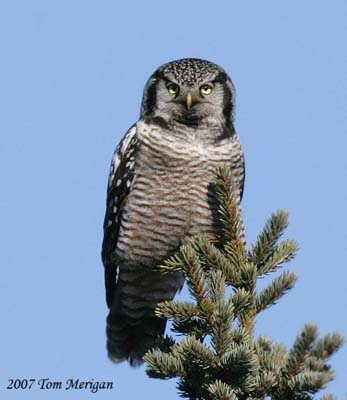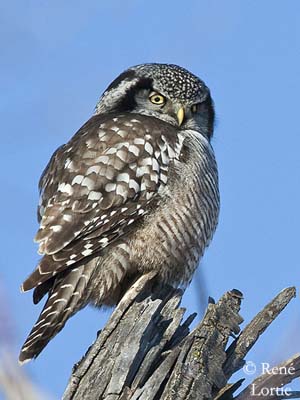
Northern Hawk Owl
Surnia ulula
Strigiforme Order – Strigidae Family
BIOMETRICS:
Length: 36-39 cm
Wingspan: 74-81 cm
Weight: M : 270-315 g – F : 320-345 g
DESCRIPTION:
Northern Hawk Owl is a medium-sized owl, a largely diurnal bird.
Adult has black, dark brown and white plumage pattern.
On the upperparts, mantle and back are dark brown. Rump and tail are blackish-brown with whitish bars. Wings show white spots on scapulars which appear as pale panel on closed wings.
Underparts are white, finely but heavily barred dark brown, including underwing and undertail. Upperbreast shows an indistinct white collar.
PROTECTION / THREATS / STATUS:
Northern Hawk Owl numbers vary according to the food resources. Deforestation and lack of nesting cavities involved declines in some parts of the range, especially in Europe.
However, populations seem to be relatively stable and not globally threatened at this moment.
Fr: Chouette épervière
All : Sperbereule
Esp : Cárabo Gavilán
Ital : Ulula
Nd : Sperweruil
Russe : Ястребиная сова
Sd : Hökuggla
Photographers :
René Lortie
http://rlortie.ca
Tom Merigan
Tom Merigan’s Photo Galleries
Text by Nicole Bouglouan
Sources :
HANDBOOK OF THE BIRDS OF THE WORLD Vol 5 by Josep del Hoyo-Andrew Elliott-Jordi Sargatal - Lynx Edicions - ISBN: 8487334253
Wikipedia (Wikipedia, The Free Encyclopedia)
What Bird-The ultimate Bird Guide (Mitchell Waite)
The Peregrine Fund – World Centre for Birds of Prey
Owling.com – The largest UN website totally dedicated to owls

Head shows greyish-white facial disk, surrounded by broad black band. Another black line runs from the eye to the hindcrown where it forms indistinct false eyes. Eyebrows are white. Crown is brown finely spotted white.
The hooked bill is horn-coloured. Eyes are pale yellow. Legs and feet are feathered and buffy-white.
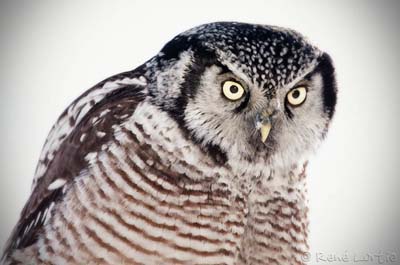
Both sexes are similar, with female slightly larger than male.
Juvenile has grey-brown upperparts less marked white.
We find three subspecies:
S.u. ulula, from N Eurasia
S.u. tianschanica, from C Asia, China and probably N Mongolia. This one is slightly larger, blacker above with small white spots.
S.u. caparoch, from Alaska, Canada to Newfoundland, and extreme Northern USA. This race is darker, blacker above and tawnier below, mainly on flanks and belly.
VOICE: SOUNDS BY XENO-CANTO
Northern Hawk Owl utters rapid “prullul-lullu” during about 14 seconds. This call uttered by the male corresponds to female’s call which is shriller, shorter and softer.
We can also hear harsh chattering “ke-ke-ke-ki” and different other sharp and trilled calls.
Contact between pairs is a soft “uhg” or “uih”.
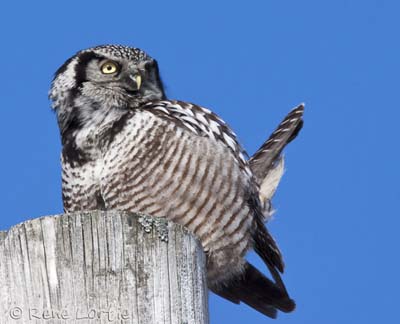
HABITAT:
Northern Hawk Owl frequents forest tundra and boreal taiga until the tree-line, and southwards, steppe forest edge and cultivated areas.
It also may be found in clearings, burnt areas and sparse woodlands with mixed trees’ species, mainly with broken-topped stumps and bare branches.
It usually avoids the dense coniferous forests.
RANGE:
Northern Hawk Owl lives in boreal forests of Eurasia and North America.
BEHAVIOUR:
Northern Hawk Owl feeds mainly on small mammals such as voles and lemmings, and it also takes small birds or larger mammals, and occasionally amphibians, fish and insects.
This species is both diurnal and nocturnal. It usually hunts from exposed perch. When the prey is detected, it pounces onto it or flies low from the ground, and may frequently hover. It can catch a prey in flight.
It also plunges into the snow when hunting. This bird is able to hear sounds coming from the substrate, up to 30 cm depth, and to detect prey by sight at great distance, up to 800 metres.
This species is often seen singly or in pairs.
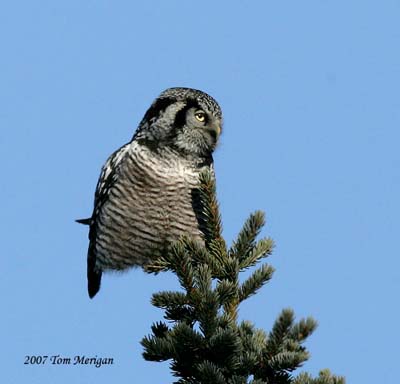
This owl has similar behaviour to hawks and falcons. It is able to hover like kestrels above the prey, before to swoop down onto it.
It hunts mainly by day, and uses its keen sight and hearing to detect the preys. Unlike other nocturnal owls, the Northern Hawk Owl has not completely silent flight.
Northern Hawk Owl performs dispersions according to the prey availability.
FLIGHT:
Northern Hawk Owl has straight flight performed with rapid wing beats interspersed with glides. This owl often hovers above the prey before to catch it.
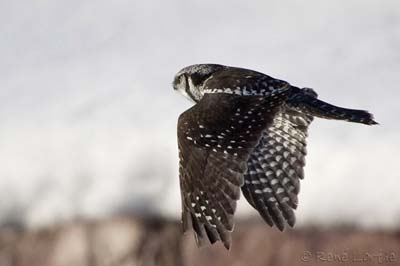
REPRODUCTION:
Breeding season occurs between March and September.
Northern Hawk Owl is a cavity nester, using hole in tree, top of stump, sometimes abandoned raptor or crow’s nest, and even nest-box. It does not add material.
Female usually lays 5-13 white eggs at 1-2 days intervals. Incubation lasts about 25-30 days by female alone. She is fed by the male during this period.
The altricial chicks are brooded by the female for about two weeks. They fledge about 25-35 days after hatching. Before to fledge, youngs often climb into the nearby branches. When fledged, they remain in the territory for 6-8 weeks more, fed and cared by both parents.
Youngs are independent at 75 days of age. They reach their sexual maturity at one year.
Parents may perform distraction displays when intruders or predators approach the nest-site.
This species produces only one brood per year, but if the eggs are lost, there will be a replacement clutch.
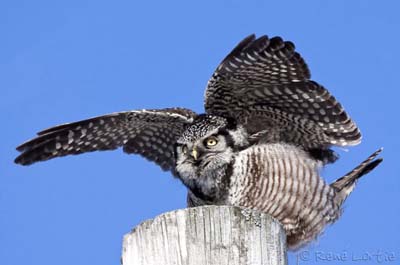
DIET:
Northern Hawk Owl feeds primarily on small mammals such as voles and lemmings, but it also takes small birds, amphibians and some fish.
It hunts from exposed perch using its keen sight and hearing, and then, it swoops down onto the prey.
